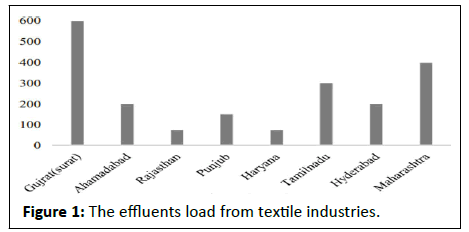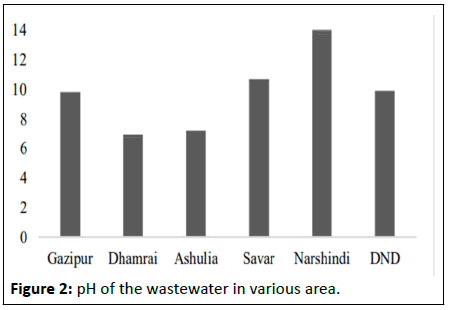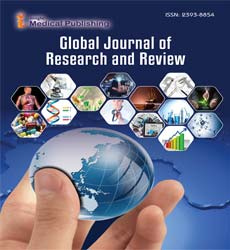ISSN : 2393-8854
Global Journal of Research and Review
A Critical Review on Environmental Pollution Causes by Textile Industry
Rofiul Islam Rofi*
Department of Textile Engineering, National Institute of Textile Engineering and Research, Nayarhat, Bangladesh
- *Corresponding Author:
- Rofiul Islam Rofi
Department of Textile Engineering, National Institute of Textile Engineering and Research, Nayarhat, Bangladesh
E-mail:rofiulislam80@gmail.com
Received date: March 14, 2024, Manuscript No. IPGJRR-24-18731; Editor assigned date: March 16, 2024, PreQC No. IPGJRR-24-18731 (PQ);Reviewed date: March 30, 2024, QC No. IPGJRR-24-18731; Revised date: March 17, 2025, Manuscript No. IPGJRR-24-18731 (R); Published date: March 24, 2025, DOI: 10.36648/2393-8854.12.1.123
Citation: Rofi RI (2025) A Critical Review on Environmental Pollution Causes by Textile Industry. Glob J Res Rev Vol:12 No:1
Abstract
Environment pollution is one of the major problem that faces by our civilization. Textile industry is one of the factor for pollute the environment. In this study various causes that occurs by textile industry and pollute the environment will be shown and described. In textile industry for energy to run the factory various kind of fuel are used and in the industry there are many chemicals and dyes are used for the textile products. Plastic is one of the main substance for making the synthetic fabric. They pollute the air, water, soil and also they pollute the ecosystem of the various animals and destroy the ozone surface of the earth. For various kind of pollution that causes by textile industry the life of normal life hampered. They got ill and many time men and women lost their organs and sometimes they got attacked by various life taking illness.
Keywords
Textile industry; Pollution; Chemical; Environment pollution; Plastic; Ecosystem; Soil; Ozone surface; Synthetic fabric
Introduction
According to Azadi, et al. and Siyanbola, et al. industries are frequently seen as the "engine" of economic growth, helping many nations achieve rapid economic expansion [1]. One of the most significant subsectors of the manufacturing sector, the textile industry helps to reshape the economy of nations like Nigeria, Bangladesh, India, Vietnam, China and Turkey. For instance, in Bangladesh, the textile and apparel industry employs 50% of the industrial labor force and generates over 77% of the nation's foreign exchange profits [2].
Many man and woman work in this industry worldwide. They earn their livelihood depends on this. But even if this sector helps us various way, it also damages the environment and our surrounding nature and the others part of living. Textile industry produce a lot of products in a year. It generates around 1 trillion dollars and 7% of the total export goods [3]. The worker number of the industry is around 35 million around the world. Even it pollutes the world around us in vary ways. It is a large section for that it also need large amount of energy. This amount of energy will cause a big problem because we get this kind of energy by burning the fossil fuel maximum time. This fossil fuel produces a large amount of the toxic gas and pollute the air. Normally textile industry produces NOx and SOx gases [4]. Those gases are very harmful for our body. It also increases the temperature of the world. Because of this the water level of sea is rising. Textile industry also use a lot of water for cleaning, dyeing etc. They also produce a lot of wastage. Those wastage release with the water by the drainage system of the industry. But those wastage goes to the various water source like river, cannel, ocean and some of them went to the soil. Because of the pollution of the water, the resource of the useable water is decreasing. In some country it is responsible for the increase of the cost of water. It also harms the soil of the land and unfertile the land with toxicity. For various pollution the natural flow of the living substance of earth. This kind of pollution happens for textile industry in our daily life. It is harmful for our future generation if they live in this polluted nature. It will also damage the climate of the global environment.
Literature Review
Objectives
To describe various kind of environmental pollution causes by textile industry: Textile industry is one of the large sector that helps to stable the economic situation of the whole world. Many country depends on this sector for the demand of remittances. It also makes connection between many countries for buying and selling the goods of the individual country. Nano fiber and micro fiber are mainly responsible for air pollution. And also the smoke that create for burning the fuel and also when there dyeing take place it gives up toxic gas that pollute the air. Because worker take breath in this environment, it causes many long-term diseases in their body.
Toxic nature of textile dye
Heavy metals like iron, lead, nickel, copper, zinc, and chromium are found in trace levels in textile dyeing effluents [4]. The poisonous and carcinogenic nature of synthetic azo dyes poses a serious risk to human health [5]. These dyeing effluents are released into nearby waterways, agricultural areas, irrigation channels, open water and ultimately into bodies of water like rivers and the sea [6]. Industrial wastewater from textile and dye processes can constantly change the turbidity, odor, noise level, temperature, pH and other parameters of the aquatic environment, resulting in changes to its physical, chemical and biological makeup that damages biodiversity, livestock, wildlife, fish and community health [7]. In addition to making surface and subsurface water extremely repulsive, dyes are known to be the cause of numerous water-borne illnesses, including dermatitis, mucous membrane perforation, nasal septal perforation and severe respiratory tract irritation. Adulteration of this aquatic system poses a serious risk to the socioeconomic and clinical environment overall [8]. The Figure 1 show the effluents load from textile industries from various state of India.
Figure 1: The effluents load from textile industries.
Air pollution
Air pollution is second greatest pollution in textile industry. Air pollution is measure by how much carbon dioxide, carbon monoxide, many metal related gas are created also SOx and NOx are also responsible for air pollution. Air pollution in textile industry mainly start in the finishing stages of textile fabric [9]. Because of many dyes, coating chemicals and paints etc. are used for coating and using boiler for coating, there toxic gas and other harmful substances are created. The main source of NO2 is the oxidation of NO, which is created at high temperatures from air nitrogen and oxygen [10]. One important precursor of ozone and particulate matter is NOx.
It may encourage the development of photochemical smog, decrease in visibility, acid rain and ozone depletion. Due to their primary components, NOx, NO and NO2, these substances gravely damaged humans by penetrating the alveoli and bronchioles in the deepest portion of the respiratory system and in severe cases, they even caused early death. Additionally, because NO2 causes acid rain and nitric acid to occur, it is harmful to ecosystems. According to Hussain and Luo, there would be a 1.01% rise in the mortality risk due to rising SO2 emissions through the respiratory system. Nearly 100 million metric tons of new products are introduced to the market yearly by the worldwide textile sector. The abundance of goods additionally illustrates how bad the textile industry's environmental impact is.
The textile industry is frequently criticized for its detrimental effects on the environment because of the large amounts of dangerous chemicals it uses and the harmful air pollutants (such as SO2 and NOx) it emits [11]. The textile industry is responsible for environmental degradation from the point of raw material purchasing to the point of finished product finishing.
Water pollution
Water is the essential substance for our life. Without drinking water not any one can live their life. One of the biggest users of water in manufacturing is the textile sector and textile wet processing in particular, which makes it one of the primary sources of industrial wastewater [12]. Surface water is often used for washing, bleaching, sizing, dyeing and printing, as a result, this water mixed with river water and causes pollution. Because of water pollution the surface water is now started to pollute at a dangerous rate. Surface water is not drinkable in some place cause the shortage of the drinking water for the living creatures. The price of the drinking water is increasing because of this. It also destroys the ecosystem of the marine ecosystem. For this reason, fish cannot collect the food for themselves from the natural resources. They often died for this and pollute the water. In the area of industries, the food for the fish in the pond or cannel is wastage of industry in maximum case [13]. Those fish always are toxic and after eating them it harms our health. pH of waste water at various place of Bangladesh shown below in Figure 2.
Figure 2: pH of the wastewater in various area.
Soil pollution
The Earth is contaminated by textile wastewater. The most crucial medium for the growth of plants, bushes, crops, etc. is the soil. The soil's quality determines the quality of the crops. Therefore, the quantity and quality of crops also drop when the soil's quality declines as a result of contaminated industrial wastewater. Additionally, since the effluents are eventually deposited in the lower lands, it is seen that the lower lands get more contaminated than the upper lands [14]. For the pollution of the soil the microorganisms those lives in the soil also started to decrease. If that matter can’t be solved, then the soil will start to loss its fertility. Various metal ion and salt are got into the soil for wastewater and pollute the soil.
Hazardous pollution
Chlorophenols (CPs), hazardous pollutants that tend to build up in textile dyeing sludge, can harm the environment [15]. Many chemicals can still be harmful to the environment and human health even when used properly, when these dangerous substances are disposed of improperly, without following the right procedures or handling care, they turn into dangerous garbage. Most commonly, hazardous waste is a byproduct of production; nevertheless, some hazardous wastes originate from our houses; paint thinner, outdated batteries and insect spray cans are just a few examples of the hazardous wastes that can be found in our rubbish. No matter where it comes from, improper disposal of hazardous waste can harm the environment and put public health at risk [16]. There are many impacts for the pollution of environment, like:
Physical impact: Micro plastic intake has the primary physical effect on living things. Vital organs and other tissues seem to be more susceptible to injury from nano plastics and their radial uptake. The central nervous system is also affected [17].
Chemical impact: Plastic and synthetics and dyes are effecting the environment and also rises the risk of enhanced biodegradability of toxic substances. Amountend nature of hydrophobic pollutants decides the chemical contamination.
Biological impact: It effects the fresh water system and damage the marine environment also ozone layer of environment.
Impact of human health: We naturally take the micro plastics by food and drinks, seafood is in it. It causes toxic attack, long time chronic ingestion.
Discussion
Concerns about the environment and human health damaging from wastewater released by the textile industry have long been prevalent worldwide. The physical and chemical feature of people, animal, plants and entire ecosystems can be changed by textile effluents that contain high quantities of dangerous chemicals and organic loads, frequently above the allowable limit. They do this by raising the price of drinking water and medical care, for example or by decreasing agricultural output, among other indirect economic consequences. This study shows the various types of pollution causes by textile industry in the environment. It also shows some impacts of the pollution. Those impacts are very damage full for our daily life and it is easy to say that this pollution will increase rapidly if we don’t do anything in our present days. We should take various necessary steps for reducing the pollution like reduce the wastewater by cleaning the water with chemical in plants, use chemical filter in chimney of outgoing gas to reduce the metal and various metal ion from gas.
Conclusion
Environment is polluted in many way and textile is major one. It pollutes our environment and damage the ecosystem. Air, soil, water etc. are the main component of the nature and textile industry pollutes them. Toxic dyes cause chemical pollution. The harmful objects, those causes many harm to our surrounding like water source pollute, decrease the soil fertility, harm the ozone layer of our earth. Those also causes various body problem to the related workers and public citizen too. Sometimes it harms our internal organs and also the because of the pollution it attacks with various diseases the children and old folks first. Water and air pollution is the main reason because water pollute soil, fresh water source on the other hand air also pollutes the whole environment. For the pollution of air heavy metal can be found and it causes lunge problem and cancer also. We should inspect the pollution rate thoroughly. Prevent increase rate of pollution, careful to our health issue will be helpful.
Acknowledgement
I would like to express my special thanks to my parents and my brother for give me the mental support and encourage me to complete this work who works. Which also helped me in doing a lot of research and I came to know about so many new things.
Conflicts of Interest
The authors declare no conflict of interest.
References
- Dadi D, Stellmacher T, Senbeta F, van Passel S, Azadi H (2017) Environmental and health impacts of effluents from textile industries in Ethiopia: The case of Gelan and Dukem, Oromia Regional State. Environ Monit Assess 189:11
[Crossref] [Google Scholar] [PubMed]
- Liu J, Liang J, Ding J, Zhang G, Zeng X, et al. (2021) Microfiber pollution: An ongoing major environmental issue related to the sustainable development of textile and clothing industry. Environ Dev Sustain 23:11240-11256
- Henry B, Laitala K, Klepp IG (2019) Microfibres from apparel and home textiles: Prospects for including microplastics in environmental sustainability assessment. Sci Total Environ 652:483-494
[Crossref] [Google Scholar] [PubMed]
- Guo Y, Zhu L, Wang X, Qiu X, Qian W, et al. (2022) Assessing environmental impact of NOX and SO2 emissions in textiles production with chemical footprint. Sci Total Environ 831:154961
[Crossref] [Google Scholar] [PubMed]
- Hasanbeigi A, Price L (2015) A technical review of emerging technologies for energy and water efficiency and pollution reduction in the textile industry. J Clean Prod 95:30-44
- Sait ST, Sørensen L, Kubowicz S, Vike-Jonas K, Gonzalez SV, et al. (2021) Microplastic fibres from synthetic textiles: Environmental degradation and additive chemical content. Environ Pollut 268:115745
[Crossref] [Google Scholar] [PubMed]
- Lellis B, Fávaro-Polonio CZ, Pamphile JA, Polonio JC (2019) Effects of textile dyes on health and the environment and bioremediation potential of living organisms. Biotechnol Res Innov 3:275-290
- Akarslan F, Demiralay H (2015) Effects of textile materials harmful to human health. Acta Phys Pol A 128:B407-B408
- Imtiazuddin SM, Tiki S, Chemicals AV (2018) Impact of textile wastewater pollution on the environment. Pakistan Textile J 68:38-39
- Tian Z, Yang Y, Wang L (2020) An improved method for assessing environmental impacts caused by chemical pollutants: A case study in textiles production. Toxicol Ind Health 36:228-236
[Crossref] [Google Scholar] [PubMed]
- You S, Cheng S, Yan H (2009) The impact of textile industry on China's environment. Int J Fash Des Technol Educ 2:33-43
- Rathinamoorthy R, Balasaraswathi SR (2021) A review of the current status of microfiber pollution research in textiles. Int J Cloth Sci Technol 33:364-387
- Aldalbahi A, El-Naggar ME, El-Newehy MH, Rahaman M, Hatshan MR, et al. (2021) Effects of technical textiles and synthetic nanofibers on environmental pollution. Polymers 13:155
[Crossref] [Google Scholar] [PubMed]
- Mia R, Selim MD, Shamim AM, Chowdhury M, Sultana S, et al. (2019) Review on various types of pollution problem in textile dyeing and printing industries of Bangladesh and recommandation for mitigation. J Textile Eng Fashion Technol 5:220-226
- Islam MR, Mostafa MG (2018) Textile dyeing effluents and environment concerns-A review. J Environ Sci Nat Resour 11:131-144
- Chen X, Ning XA, Lai X, Wang Y, Zhang Y, et al. (2021) Chlorophenols in textile dyeing sludge: Pollution characteristics and environmental risk control. J Hazard Mater 416:125721
[Google Scholar] [PubMed]
- Islam T, Repon MR, Islam T, Sarwar Z, Rahman MM (2023) Impact of textile dyes on health and ecosystem: A review of structure, causes, and potential solutions. Environ Sci Pollut Res Int 30:9207-9242
[Crossref] [Google Scholar] [PubMed]
Open Access Journals
- Aquaculture & Veterinary Science
- Chemistry & Chemical Sciences
- Clinical Sciences
- Engineering
- General Science
- Genetics & Molecular Biology
- Health Care & Nursing
- Immunology & Microbiology
- Materials Science
- Mathematics & Physics
- Medical Sciences
- Neurology & Psychiatry
- Oncology & Cancer Science
- Pharmaceutical Sciences


